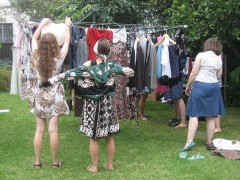 Sustainable fashion: The facts
Sustainable fashion: The facts
Sustainable fashion is a new buzz term and means clothing that is ecologically and environmentally friendly both in the products used and the process by which they are produced. If you were truly to buy sustainable fashion, though, this would mean not buying anything with products in it that would affect the planet for the next generation. This, clearly, is extremely hard to do in a world where fashion is transient and all about novelty, but there are still some small changes you can make to live a more sustainably conscious lifestyle.
Organic, ethical and Fairtrade are three terms that green fashionistas need to be on the hunt for. As well as this it is now even possible to recycle plastic bottles into fabric. Current designers are more under pressure now than ever to use sustainable products in their clothing ranges. Instead of the tie-dye, hippy styles that are normally associated with eco fashion, designers are starting to experiment with new techniques and fabrics in order to bring a whole new lease of life to the term “sustainable fashion”.
There seems to only really be one down side to sustainable fashion and its processes and this is the cost. Typically organic and Fairtrade products are more expensive due to the complicated processes involved in their production {alternative energy, improved irrigation, low impact dyes and sweatshop free labour} and the fact that new “eco” pest control methods have been created to avoid too many harmful chemicals that could affect workers and agriculture alike. New GM {Genetically Modified} cotton has reduced the amount of land needed for growth and has improved crop yields.
Some fabrics are even made from plant cellulose or plant and animal proteins. These are biodegradable so are better for the environment. Fabrics that are created from plant cellulose do require a regeneration process to transform the natural sources into fibres. Pine, Spruce and residue cotton fibres can make Rayon. These processes can sometimes be chemically intensive, however, it is now possible to recycle and reuse certain chemicals and solvents which is better for the environment as well as cheaper for the manufacturer.
The easiest way to be truly sustainable, however, is to use fabrics that have previously been made into garments ie. post consumer fabric. Clothes swaps are hugely popular these days. The concept is that you take some garments down that you no longer want and swap them for other garments you do want. Even if you are simply swapping the garments for the fabric it is a great way to re-use and ‘up-cycle’. Such creativity has been around for hundreds of years from the great depression through several World wars. People are used to times being tough or environmental constraints and many love the challenge of creating something new from something old. Many fashion designers pride themselves on their ability to produce unusual and one-off pieces from pre-loved fabrics.
In short, sustainable fashion is not a trend. It is a way to pave a better future for the planet and generations to come. As a world we can no longer live in denial about the state of the planet and our part in it so doing our bit is extremely important.
Author Bio: Mia Hodgkinson is a fashion and environmental enthusiast working on behalf of Banana Moon Clothing.
Image: License![]()
![]() Some rights reserved by somaya
Some rights reserved by somaya
One easy, affordable way to be more “sustainable” is to also buy used clothing so it’s recycled.
Another, more expensive way, is you can buy from local designers who produce the clothes in the US (and yes, this is generally a lot more expensive paying for American labor). But it’s also worth it because a lot of times the clothes last a lot longer versus something from Forever 21 or Old Navy which are more like throw-away clothes based on the shelf-life. I’ve bought local designers where the clothes were also made in the city and they’ve lasted for over 10 years+. So that “extra cost” ends up working out over the course of all the years used.
Clothes swaps are great
Green clothing in Vermont! http://www.siftcouture.com/